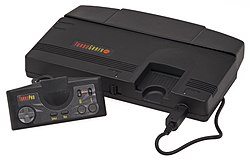
Back توربو غرافيكس-16 Arabic توربوجرافكس-16 ARZ PC Engine AST PC Engine Breton PC Engine Catalan TurboGrafx-16 Czech PC Engine German PC Engine Spanish توربوگرافاکس-۱۶ Persian PC Engine Finnish
This article needs additional citations for verification. (May 2023) |
  | |
  North American TurboGrafx-16 (top) and the original Japanese PC Engine (bottom) | |
| Manufacturer | NEC · Hudson Soft |
|---|---|
| Type | Home video game console |
| Generation | Fourth |
| Release date | |
| Lifespan | 1987–1994 |
| Discontinued | |
| Units sold |
|
| Media | HuCard |
| CPU | HuC6280 @ 7.16 MHz |
| Memory | |
| Display | Composite or RF TV out; 565×242 or 256×239, 512 color palette, 482 colors on-screen
|
| Graphics | |
| Sound | PSG, 5 to 10-bit stereo PCM |
| Best-selling game | Bonk's Adventure[2] |
| Successor | |
The TurboGrafx-16, known as the PC Engine[a] in Japan, is a home video game console designed by Hudson Soft and sold by NEC. Released in Japan in 1987 and in North America in 1989, it was the first console of the fourth generation, often called the 16-bit era. Initially launched in Japan to compete with Nintendo's Famicom, the system’s delayed U.S. release pitted it against the more advanced Sega Genesis and, later, the Super NES.
The TurboGrafx-16 features an 8-bit CPU and a dual 16-bit GPU chipset, consisting of a video display controller (VDC) and a video color encoder (VCE) capable of displaying 482 colors simultaneously out of 512. With dimensions of 14 by 14 by 3.5 centimetres (5.5 in × 5.5 in × 1.4 in), the PC Engine remains the smallest major home game console ever produced.[3][4] Games were released on HuCard cartridges, with later support for CD-ROMs via the TurboGrafx-CD add-on. The “16” in the console’s North American name and the marketing of the console as a 16-bit platform despite having an 8-bit CPU was criticized by some as deceptive.[5]
In Japan, the PC Engine was a commercial success, gaining strong third-party support and emerging as the Super Famicom's primary rival. However, the TurboGrafx-16 struggled in the U.S., hindered by a delayed release, weaker marketing, and stiff competition.[6] In Europe, Japanese models were grey-market imported and modified for sale in France and the UK,[7][8] though plans for an official PAL version (simply branded as "TurboGrafx") were scrapped after disappointing U.S. sales, with leftover stock liquidated through mail-order retailers.[9]
Over 17 different versions of the console were produced, including portable models and those integrating the CD-ROM add-on.[10] In 1989, NEC rushed out the PC Engine SuperGrafx, a more powerful version intended to replace the standard PC Engine. It failed to gain traction, with only six games released to support its enhanced capabilities, and was soon discontinued. Production of the final PC Engine model ended in 1994. It was succeeded by the PC-FX console, which was released exclusively in Japan and also failed commercially.
- ^ "Retro Sales Age Thread".
- ^ "Bonk's Adventure Virtual Console Review - Wii Review at IGN". Wii.ign.com. Archived from the original on April 14, 2012. Retrieved August 15, 2012.
- ^ Guinness World Records Gamer's Edition (2008)
- ^ McFerran, Damien (November 2, 2012). "Feature: The Making of the PC Engine". Nintendo Life. Archived from the original on July 30, 2019.
- ^ Therrien, Carl; Picard, Martin (April 29, 2015). "Enter the bit wars: A study of video game marketing and platform crafting in the wake of the TurboGrafx-16 launch". New Media & Society. 18 (10): 2323–2339. doi:10.1177/1461444815584333. S2CID 19553739.
- ^ Nutt, Christian (September 12, 2014). "Stalled engine: The TurboGrafx-16 turns 25". Gamasutra. Archived from the original on June 27, 2017.
- ^ Cite error: The named reference
CVG130was invoked but never defined (see the help page). - ^ Cite error: The named reference
Agewas invoked but never defined (see the help page). - ^ Sartori, Paul (April 2, 2013). "TurboGrafx-16: the console that time forgot (and why it's worth re-discovering)". The Guardian. Archived from the original on July 1, 2018.
- ^ Stuart, Keith; Freeman, Will (February 27, 2016). "Why Kanye West is right to recommend the TurboGrafx-16". The Guardian. Archived from the original on June 22, 2017. Retrieved December 25, 2017.
Cite error: There are <ref group=lower-alpha> tags or {{efn}} templates on this page, but the references will not show without a {{reflist|group=lower-alpha}} template or {{notelist}} template (see the help page).
© MMXXIII Rich X Search. We shall prevail. All rights reserved. Rich X Search